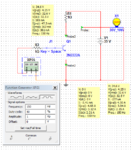ConfusedCircuitBoy
Newbie level 4
Hi,
Thanks a lot for reading this message. We've never worked with fluorescent bulbs before, so we're having a lot of trouble...
We're trying to power this bulb:
**broken link removed**
It apparently requires 35V AC to power it.
We're planning on having USB (5V, 100-500mA output) charge a battery. We haven't figured out the specs of the battery yet, but we're thinking it will be 3.5-6V.
We need to take the voltage from the battery, convert it to 35V AC to power the bulb. How can we do this? Would the battery simply run on 35V DC? That might be a lot simpler since the battery is in DC and we'd just need some sort of boost converter.
If we do need 35V AC to power the bulb, can we use some circuit that simulates AC? Our initial design (which is not good) is attached.

Any help would be really appreciated. If there are parts available that do what we need that you can guide us to, that would be extremely helpful.
Thanks so much!!!
Thanks a lot for reading this message. We've never worked with fluorescent bulbs before, so we're having a lot of trouble...
We're trying to power this bulb:
**broken link removed**
It apparently requires 35V AC to power it.
We're planning on having USB (5V, 100-500mA output) charge a battery. We haven't figured out the specs of the battery yet, but we're thinking it will be 3.5-6V.
We need to take the voltage from the battery, convert it to 35V AC to power the bulb. How can we do this? Would the battery simply run on 35V DC? That might be a lot simpler since the battery is in DC and we'd just need some sort of boost converter.
If we do need 35V AC to power the bulb, can we use some circuit that simulates AC? Our initial design (which is not good) is attached.

Any help would be really appreciated. If there are parts available that do what we need that you can guide us to, that would be extremely helpful.
Thanks so much!!!